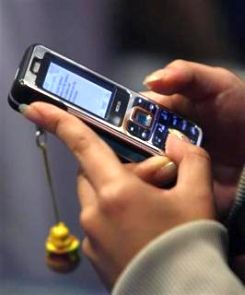 Discussions are on in government about how to make the process simpler for the poor and more cost-effective for telecom operators, says Subhomoy Bhattacharjee.
Discussions are on in government about how to make the process simpler for the poor and more cost-effective for telecom operators, says Subhomoy Bhattacharjee.
The Jan-Dhan Yojana is poised for a huge leap by extension of its banking platform to phones not connected to the internet.
It is the next big thing on the government's financial inclusion programme.
"We are holding some very interesting discussions at this stage," said a top government official. The discussions are about how to make the process simpler for the poor and more cost-effective for telecom operators. It is expected to be rolled out soon.
Jan-Dhan Yojana offers a bank account to potentially adult Indians. But if the account holders want to do their banking business via their mobiles, it is only possible if they have a smartphone or at least a feature phone. Else, they need to use an SMS service, which, too, costs money and is difficult and limited in its scope in rural areas.
For them, the practical options are to either visit a banking correspondent, who provides connectivity, or use their RuPay card, where an ATM is available to withdraw money.
The government desperately wants to bridge this gap to make Jan-Dhan a way of life with the poor. As of now, most transactions in these accounts are bunched around the time the government makes a periodic transfer of subsidy to the identified people.
The poorest segment of the population does not use this banking channel for any other purpose to become a conduit for their savings or to transfer money for payment. The option is to make banking services via the unstructured supplementary service data (USSD) technology -- that had become technically possible in India some time ago -- take off. It has not been popular, as it is not offered free by most telecom operators, except for government-run BSNL and MTNL.
The way USSD runs is as follows: For those who have just a 2G phone offering only voice communication, the National Payments Corporation of India (NPCIL) runs this common platform for all banks. When a customer dials a short code like *99# from her mobile, the service is activated. The service prompts the customer to dial another code. It is like a postal pincode that identifies her with the bank. It then prompts her to enter her four-digit mobile personal identification number, or PIN, which connects her with her account. The format is akin to how customers check balance on prepaid mobile services or load caller tunes.
Despite the apparent simplicity, the three-stage authentication makes it difficult for typically those who are the poorest. They need to keep note of these numbers for their transactions. It is what switches them off from the benefits that the Jan-Dhan project offers. Since there is a cost involved from telecom companies, this, too, acts as a disincentive.
There are 3 options for mobile banking
SMS/text alerts
Unstructured Supplementary Service Data (USSD)
USSD technology
Unique to GSM; capability built into such phones
Allows session-based communications like top-up, caller tunes downloads
NPCIL using national unified USSD platform to provide banking service to the unbanked
Gets a bank customer to access services with a single number valid across all banks
Agnostic to telecom operator or type of handset service
Banks provide free connectivity unlike SMS service
Works on voice connectivity
Safer than SMS
No application to be downloaded Offers balance enquiry, data on past transactions, money transfer
Three-stage process
To keep them interested, the government entities plan to telescope the three stages to at least two by using the Aadhaar card as an identifier on the USSD platform. The department of financial services in the finance ministry has made this one of its top priority. Once operational, it will allow customers with mobile phones to check their balance, their past three transactions and pay money for any purpose.
The government agencies, including the Reserve Bank of India and NPCIL, are also considering options to cut down or eliminate the charges levied by telecom operators -- cutting it out runs the risk of companies putting less bandwidth to provide the service. This will be a disincentive for bank customers.
Shankar Maruwada, former head of demand generation and marketing at Unique Identification Authority of India, says the Aadhaar numbers are geared to take on the role. "They have been designed for being linked with bank accounts. Using them as identifier from non-internet based phones should not be a problem".
It is a technological jump no country has attempted so far, though. "But, then no country has quite extended its banking channels so deep too," said an official. As on September 14, there were 244.4 million Jan-Dhan accounts with various types of banks. Of these, around half or 51 per cent are seeded with Aadhaar numbers.
The operating environment is quite different from those who use smartphones to tap into banking services. Indian banks, like their counterparts elsewhere in the world, use a 128-bit operating system to offer netbanking to their customers. Once a customer opens a window on her mobile, the operating system of her bank takes over that particular window and lets her safely conduct a transaction.










